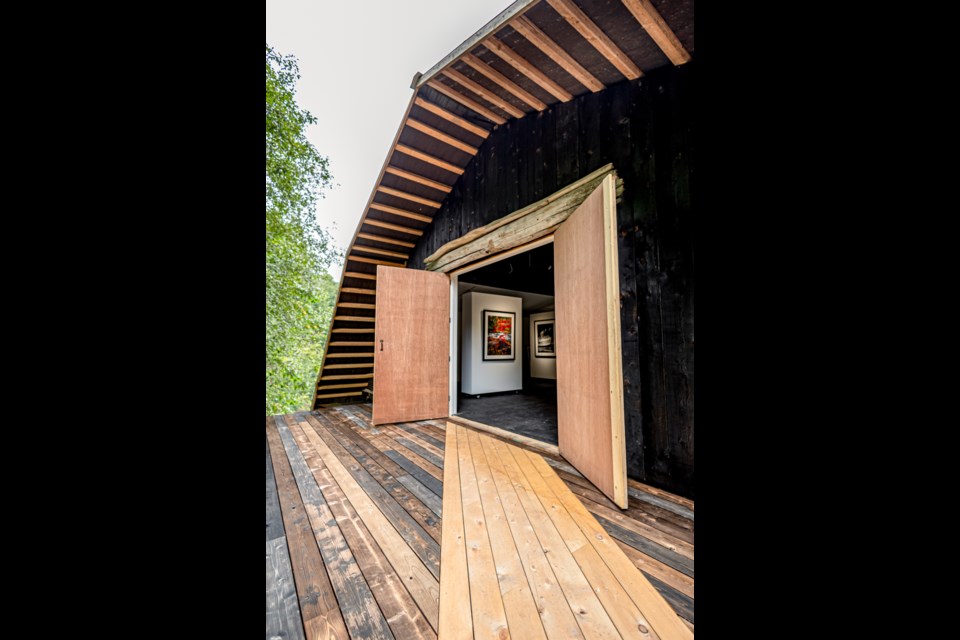The world of photography has rapidly changed since the digital takeover in the early 2000s, and with the invention of smartphones, the photograph is now in the palm of most people’s hands.
Gallery in the forest
With the opening of his Stillwater Gallery in the middle of a forest in qathet, Canadian landscape photographer Ron Smid hopes to entice folks to see and immerse themselves in an artform that once was. What was a pole barn from the 1970s has now been transformed into what Smid says is Canada's largest traditional photographic landscape gallery. He describes the space on his website ronsmid.com as a 2,500-square-foot facility, which includes both a main exhibition gallery and a custom analog darkroom studio where he continues to work with an 1800s black and white silver gelatin printing process.
"We had purchased the property nearly 20 years ago, but I was not here because I was travelling and photographing, creating work across Canada," said Smid. "I was going back and forth across Canada, and I had a vision to open up a studio here, however, I decided to open up in Whistler instead."
Smid had his gallery in the mountain town of Whistler for four years but always envisioned bringing the gallery to Stillwater, and since September, his dream has come true.
"I haven't planned an opening yet, but I am taking in small groups at a time, because I feel they get more of an experience on a personal level, with the artist, by walking in and moving through the location," said Smid. "Some people have spent over three hours here with me."
Colour and black and white landscapes
Images taken on Smid's travels across Canada can be seen on the gallery walls and in his book called Canada - The Light on Our Land, a colour series containing images from all 10 provinces in Canada.
Smid said the photographs are printed on the now discontinued 1963 Cibachrome analog colour process.
"I do everything analog; there's no digital whatsoever," said Smid. "Because of the natural setting surrounded by forests, I want the world to come here as part of their journey or travel plans."
Smid describes the gallery as feeling more like a museum and said his 1974 Deardorff wood camera sets the stage for creating a turn-of-the-century feeling, when the first Deardorff was created.
"By capturing [landscapes] on a large film, which allows for more detail, combined with traditional analog darkroom process, now you have a three-dimensional aspect as well attached to [the photograph]," said Smid. "It feels like you're looking out a window, so that's the uniqueness of this process and there's nothing to replicate that."
Smid said a majority of the younger generation has not seen a quality photograph from a large piece of film in their entire lives. That's probably true now for most people, young and old, unless intentionally working with the film medium.
"That's why I have my [landscape photography] on display, to try to celebrate the traditional photographic process," said Smid. "I want to show people what the analog photographic process is and the life force that comes off of an analog photograph, compared to looking at a screen."
Slow photography
Smid said everyone is so used to looking at images on a screen that's quite small in comparison to seeing large film photographs in an exhibition space, in the middle of the forest. The experience can be zen-like, he added.
"I've created a very large exhibition space for people to walk around and the pieces are well apart," said Smid. "They [patrons] can stand back and look at the photographs, and they can feel immensely connected to [the photographs] by taking the time to look at the dimensional aspect of it."
Smid said his photographs look three-dimensional and many folks who have taken them home feel like they bring a sense of peace and relaxation into the home.
Some people have named Smid's style slow-photography, since the setup of the camera, capturing the right light and moment, can take time.
"I once drove across Canada from BC to Nova Scotia and I spent three months on the road, travelled 20,000 kilometres in search of photographs, and I came home with six images," said Smid. "I'm looking for a particular alignment of line and light to converge in such a synchronicity, and when I see that happening, I know it's now part of the series."
Gallery tours for groups and individuals
Smid amassed his photographs over decades of travel in his 20s and 30s, across Canada, when sharing images wasn't easy.
"To work in both mediums [colour and black and white] in this traditional process is very rare," said Smid. "I want to share this art form with the next generation or else, we lose it."
Contact Smid for an individual or group tour of the Stillwater Gallery at 604.483.6699, [email protected] or his website ronsmid.com.
Join the Peak’s email list for the top headlines right in your inbox Monday to Friday.




